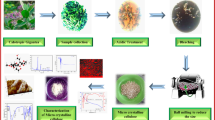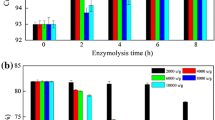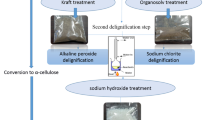Abstract
Suitable α-cellulose and cellulose II powders for use in the pharmaceutical industry can be derived from maize cob. α-Cellulose was extracted from an agricultural residue (maize cobs) using a non-dissolving method based on inorganic substances. Modification of this α-cellulose was carried out by its dissolution in the ionic liquid 1-butyl-3-methylimidazolium chloride ([C4mim]Cl), and subsequent regeneration by addition of either water or acetone at room temperature, or of boiling water. X-ray diffraction and infrared spectroscopy results showed that the regenerated celluloses had lower crystallinity, and proved that the treatment with [C4mim]Cl led to the conversion of the crystalline structure of α-cellulose from cellulose I to cellulose II. Thermogravimetric analysis and differential scanning calorimetry data showed quite similar thermal behavior for all cellulose samples, although with somewhat lower stability for the regenerated celluloses, as expected. The comparison of physicochemical properties of the regenerated celluloses and the native cellulose mainly suggests that the regenerated ones might have better flow properties. For some of the characterizations carried out, it was generally observed that the sample regenerated with boiling water had more similar characteristics to the α-cellulose sample, evidencing an influence of the regeneration strategy on the resulting powder after the ionic liquid treatment.



Similar content being viewed by others
References
Azubuike CPC, Okhamafe AO, Falodun A (2011) Some pharmacopoeial and diluent-binder properties of maize cob-derived from α-cellulose in selected tablet formulations. J Chem Pharm Res 3:481–488
Bhimte NA, Tayade PT (2007) Evaluation of microcrystalline cellulose prepared from sisal fibers as a tablet excipient: a technical note. AAPS PharmSciTech 8(1):Article 8 28
Bradley AE, Hardacre C, Holbrey JD, Johnston S, McMath SEJ, Nieuwenhuyzen M (2002) Small-angle x-ray scattering studies of liquid crystalline 1-alkyl-3-methylimidazolium salts. Chem Mater 14:629–635
Brennecke JF, Maginn EJ (2001) Ionic liquids: innovative fluids for chemical processing. AIChE J 47:2384–2389
British Pharmacopoeia Commission (1993) British Pharmacopoeia, vol. 1. HMSO Press, London, p 53
Carr RL Jr (1965) Evaluating flow properties of solids. Chem Eng 72:163–168
Doelker E, Gurny R, Schurz J, Jánosi A, Matin N (1987) Degrees of crystallinity and polymerization of modified cellulose powders for directing tableting. Powder Technol 52:207–213
Fowler HW (2000) Powder flow and compaction. In: Carter SJ (ed) Cooper and Gunn’s tutorial pharmacy, 6th edn. CBS Publishers, Delhi
Hallett JP, Welton T (2011) Room-temperature ionic liquids: solvents for synthesis and catalysis. 2. Chem Rev 111:3508–3576
Hausner HH (1967) Friction conditions in a mass of metal powders. Int J Powder Metall 3:7–13
Isogai I (1994) Allomorphs of cellulose and other polysaccharides. In: Gilbert RD (ed) Cellulosic polymers, blends and composites. Hanser/Gardner Publications, Cincinnati
Kumar V, Reus-Medina ML, Yang D (2002) Preparation, characterization, and tableting properties of a new cellulose-based pharmaceutical aid. Int J Pharm 235:129–140
Landín M, Martínez-Pacheco R, Gómez-Amoza JL, Souto C, Concheiro A, Rowe RC (1993) Effect of batch variation and source of pulp on the properties of microcrystalline cellulose. Int J Pharm 91:133–141
Nelson ML, O’Connor RT (1964) Relation of certain infrared bands to cellulose crystallinity and crystal lattice type. II. A new infrared ratio for estimation of crystallinity in cellulose I and II. J Appl Polym Sci 8:1325–1341
Pandey A, Soccol CR, Nigam P, Soccol VT, Vandenberghe LPS, Mohan R (2000) Biotechnological potential of agro-industrial residues. II Cassava bagasse. Bioresour Technol 74:81–87
Peck GE, Bailey GJ, McCurdy VE, Banker GS (1989) Tablet formulation and design. In: Lieberman HA, Lachman L, Schwarz JB (eds) Pharmaceutical dosage forms: tablets, vol 1, 2nd edn. Marcel Dekker, New York
Reus Medina ML, Kumar V (2006) Evaluation of cellulose II powders as potential multifunctional excipient in tablet formulations. Int J Pharm 322:31–35
Reus Medina ML, Kumar V (2007) Comparative evaluation of powder and tableting properties of low and high degree of polymerization cellulose I and cellulose II excipients. Int J Pharm 337:202–209
Segal L, Creely JJ, Martin AE Jr, Conrad CM (1959) An empirical method for estimating the degree of crystallinity of native cellulose using the x-ray diffractometer. Text Res J 29:786–794
Stark A, Seddon KR (2007) Ionic liquids. In: Seidel A (ed) Kirk-Othmer encyclopedia of chemical technology, vol 26, 5th edn. Wiley, Hoboken
Sun N, Rahman M, Qin Y, Maxim ML, Rodríguez H, Rogers RD (2009) Complete dissolution and partial delignification of wood in the ionic liquid 1-ethyl-3-methylimidazolium acetate. Green Chem 11:646–655
Sun N, Jiang X, Maxim ML, Metlen A, Rogers RD (2010) Use of polyoxometalate catalysts in ionic liquids to enhance the dissolution and delignification of woody biomass. ChemSusChem 4:65–73
Sun N, Rodríguez H, Rahman M, Rogers RD (2011) Where are ionic liquid strategies most suited in the pursuit of chemicals and energy from lignocellulosic biomass? Chem Commun 47:1405–1421
Swatloski RP, Spear SK, Holbrey JD, Rogers RD (2002) Dissolution of cellulose with ionic liquids. J Am Chem Soc 124:4974–4975
Toğrul H, Arslan N (2003) Flow properties of sugar beet pulp cellulose and intrinsic viscosity–molecular weight relationship. Carbohydr Polym 54:63–71
Wang L, Han G, Zhang Y (2007) Comparative study of composition, structure and properties of Apocynum venetum fibers under different pretreatments. Carbohydr Polym 69:391–397
Wells JI (1988) Pharmaceutical preformulation: the physicochemical properties of drug substances. Wiley, New York
Werner S, Haumann M, Wasserscheid P (2010) Ionic liquids in chemical engineering. Annu Rev Chem Biomol Eng 1:203–230
Zhu S, Wu Y, Cheng Q, Yu Z, Wang C, Jen S, Ding Y, Wu G (2006) Can cellulose rival petroleum? Green Chem 8:325–327
Author information
Authors and Affiliations
Corresponding author
Rights and permissions
About this article
Cite this article
Azubuike, C.P., Rodríguez, H., Okhamafe, A.O. et al. Physicochemical properties of maize cob cellulose powders reconstituted from ionic liquid solution. Cellulose 19, 425–433 (2012). https://doi.org/10.1007/s10570-011-9631-y
Received:
Accepted:
Published:
Issue Date:
DOI: https://doi.org/10.1007/s10570-011-9631-y




